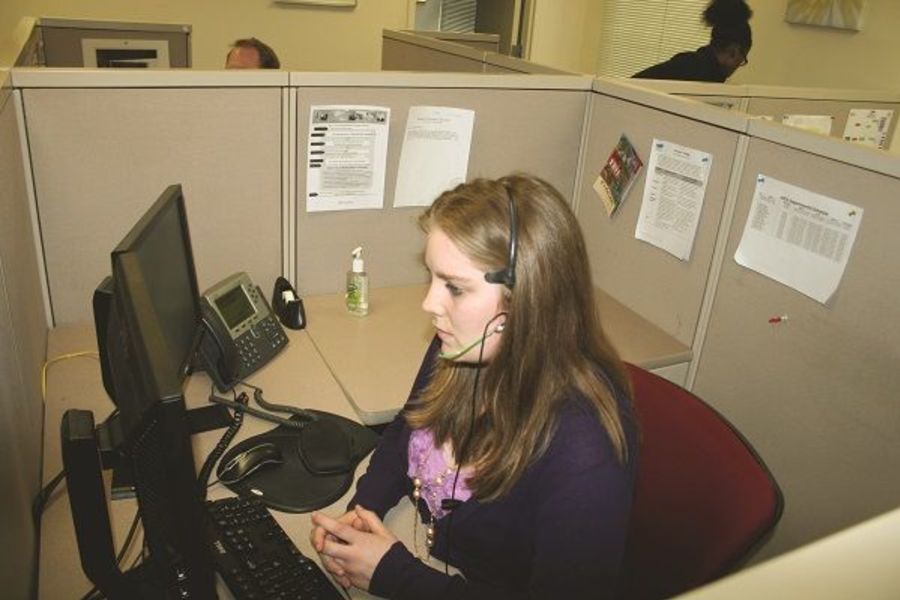Homelessness Prevention Call Center

Locations
- Catholic Charities Chicago, Illinois
Focus Areas
- Criminal Justice
- Housing
- Self-Sufficiency
“It can be costly to prevent a family from becoming homeless. However, we know that the long-term costs to society are much greater when a family becomes homeless, including children doing poorly in school and a greater likelihood that family members end up in the emergency room.”
The Issue
Over 2 million Americans experience homelessness each year. In its 2019 count of the number of people who were experiencing homelessness on a single given night, the Department of Housing and Urban Development found that 568,000 Americans were sleeping in homeless shelters or on the streets. Of these 568,000 people, 172,000 were in families with children. And 35,000 were under the age of 25, experiencing homelessness on their own. This is not only crushing, but also expensive. Homelessness brings significant public costs, and it has dire economic, health, and social consequences for those involved.
While America’s overall homelessness rate is declining, it’s growing steadily in some states. Take California, where homelessness increased by 21% between 2018 and 2019. That’s a 21% increase in a single year. And rising housing prices are only compounding the problem. Researchers define households that use 30% or more of members’ monthly income to cover rent as cost-burdened. Households that spend more than 50%? Severely cost-burdened. Research by Jeff Larrimore of the Federal Reserve Board of Governors and Jenny Schuetz of the Brookings Institution find that the average American renter in the bottom 20% of the income distribution pays 56% of their monthly income on rent, leaving less than $500 to pay for other necessities like food, transportation, and utilities. The rent burden is particularly heavy for low-income families with children.
Even in communities where housing prices aren’t skyrocketing, many families don’t have the savings or liquidity they need to overcome unpredictable life crises. Whether it’s car trouble, a drop in hours at work, or an emerging health issue, they’re one crisis away from homelessness.
The cost of providing shelter to someone who falls homeless for the first time is around $2,400. Add in the costs of basic necessities, healthcare, and social services, and this number can easily triple. And experiencing homelessness even once often leads to many future costs. Those who experience homelessness are more likely to suffer adverse health problems, resulting in frequent hospital visits. They are also more likely to be involved with the criminal justice system, which can lead to incarceration and deeper social wounds.
For kids who experience homelessness, frequent moves and unsteady environments make it difficult to succeed in school. They’re less likely to graduate from high school and college than their peers, putting them at greater risk of criminal justice involvement and unsustainable, low-wage employment. This, in turn, can lead to poverty and more homelessness.
Nationally, there are many kinds of programs available to those who are at risk of homelessness. Many states offer temporary housing arrangements and financial assistance for those on the brink, and most states operate call centers that connect people with resources to help pay their rent and utility bills.
But solving homelessness continues to be a major policy challenge, and there’s little evidence as to whether these programs actually work. We need research to determine which interventions help those who are experiencing homelessness get back on their feet. Even more importantly, we need to know how to keep them from falling into homelessness in the first place.
The Intervention
The Homelessness Prevention Call Center (HPCC) is a centralized processing center designed to help Chicago residents at risk of becoming homeless. Individuals in crisis may call 3-1-1 to request temporary housing assistance for their monthly rent, security deposits, or utility bills. Callers are transferred to the HPCC where they are screened for eligibility. Eligible callers are then connected with local funding agencies that can provide for their immediate financial needs.
Research Question
Does providing temporary financial assistance to individuals who are at risk of falling into homelessness reduce the likelihood they will enter a homeless shelter?
Intended Outcomes
- HPCC callers who receive immediate rental assistance from a local agency will be less likely to enter a homeless shelter 3, 6, and 12 months after their call than callers who do not.
- In the 6 months following their call, those who are offered financial assistance will spend fewer days in homeless shelters than those who are not.
- Providing temporary financial assistance for those at-risk of eviction can be more cost-effective than providing emergency shelter services.
Research Study Design
The HPCC project is a quasi-experimental study, and the first study in the U.S. that examines the direct impact of financial assistance on homelessness. The HPCC receives around 75,000 calls each year. To be eligible to receive emergency financial assistance, callers must face imminent risk of homelessness or utility shut-off, they must be self-sufficient after receiving the assistance, and their current crisis must be solvable by the funding they receive.
Like all nonprofits, the agencies connected to the HPCC have limited resources, which means they don’t have the capacity to meet the needs of everyone who calls. And because funding availability varies unpredictably over time, some individuals will call the HPCC while agencies have funding available, and others will call when funding is not available. This effectively randomizes HPCC callers.
Our researchers compared the housing outcomes of those who called when funding was available to those who called when funding was unavailable.
(Photo credit: Catholic Charities Chicago - Homelessness Prevention Call Center)